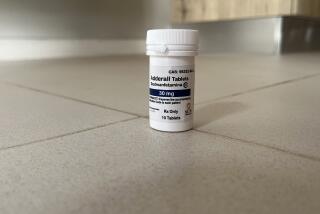Stroke victims slow to go to ER
If you, or someone else, are showing any of the warning signs of stroke, don’t hesitate -- call for an ambulance. It’s simple advice, but most people don’t heed it.
That’s the conclusion of two new studies released last week that examined whether Americans are getting the most advanced treatment for stroke caused by a blood clot. The treatment, a drug called tissue plasminogen activator, can break up a blood clot if given three to six hours after symptoms begin.
The idea that stroke should be treated as a medical emergency has been around for more than a decade. But both studies show most people are not taking it to heart. In one study, published in the Feb. 14 issue of the journal Neurology, only 43 people among 2,097 stroke patients -- or 2% -- were diagnosed with this type of stroke in time for the clot-busting medication to prevent permanent damage from the lack of blood flow.
Among those not receiving the drug, 35% were unable to say when their symptoms began and 38% arrived at the hospital more than three hours after the symptoms began -- too late for the drug to be of help.
Studies show tissue plasminogen activator can dramatically decrease the long-term consequences of stroke, such as paralysis and difficulties with memory, speech and emotional control. “It’s very important to be able to tell the medical staff when symptoms started,” says Dr. Mathew Reeves, an assistant professor of epidemiology at Michigan State University and author of the study. “It could mean the difference between receiving treatment and not receiving treatment.”
The study also found that people who arrived by ambulance were seven times more likely to receive the drug than those who arrived on their own. According to experts, ambulance transport is not only quicker, paramedics can perform some preliminary tests and insert an IV line.
“Time is so important. Every minute counts,” says Dr. Yousef M. Mohammad, the author of a second stroke study, presented last week at the American Stroke Assn.’s annual meeting in Florida. “There is a significant difference in what happens when you arrive by ambulance and when you arrive some other way.”
In his analysis of 630,402 stroke patients, about half arrived by ambulance; 43% were walk-in patients (who arrived on their own or were driven by someone else); and 4% arrived some other way, such as by police transport.
The study found that those who arrived by ambulance were seen by a doctor sooner, were more likely to undergo tests to diagnose the stroke and were more likely to be admitted to the intensive care unit -- all factors that increase the use of tissue plasminogen activator. When arriving by ambulance, stroke patients were admitted to the hospital 93% of the time; walk-ins were admitted 58% of the time.
“This is a wake-up call,” says Mohammad, assistant professor of neurology and director of the Stroke Fellowship Program at Ohio State University. “The public needs to call 911. The second message is for the emergency room triage. It has to treat patients, whether they come in by ambulance or walk in, urgently.”
No one knows why Americans have failed to heed the advice that strokes require urgent care. People are much more likely to call for an ambulance when they think they’re having a heart attack, perhaps because of the pain, Mohammad says. “With stroke, you don’t have pain. You have numbness and weakness,” he says. “Patients may say, I’ll wait and see what happens. But by the time they wait, the opportunity [for treatment] is missed. We need to remind people that stroke is the No. 1 cause of long-term disability.”
*
The symptoms of stroke are:
* Sudden numbness or weakness in the face, arm or leg, especially on one side of the body.
* Sudden confusion, trouble speaking or understanding.
* Sudden trouble seeing in one or both eyes.
* Sudden trouble walking, dizziness, loss of balance or coordination.
* Sudden severe headache with no known cause.
More to Read
Start your day right
Sign up for Essential California for news, features and recommendations from the L.A. Times and beyond in your inbox six days a week.
You may occasionally receive promotional content from the Los Angeles Times.






